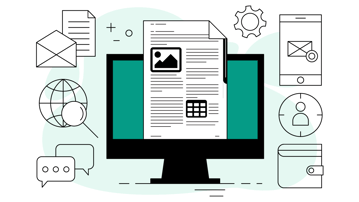It’s that simple. Yet, APMP reports that process satisfaction has dropped from 60% to 39% over the last year. Join us as we delve into the proposal management process and explore tips and best practices for boosting its efficiency and effectiveness for your business.
Common Frustrations
Proposals. The mere mention of the word induces a collective groan from E&R and construction to IT and government contracting offices alike. That’s because they are seen as time-consuming administrative burdens that drain the energy and expertise out of subject matter experts. Why?
Proposals are essentially a formal sales pitch, a document that promises to solve a client’s specific need. Here's the problem. Proposals are often treated as nothing more than a transactional exercise and a document production task. This is what makes them so frustrating. Despite this perception, there are still endless revisions, right deadlines, and the understanding that all of this hard work might not pay off in the end.
In our experience, top frustrations include situations that consume more than their fair share of the proposal development timeline:
- Slow go/no go decisions
- Confusion about what to write and how to improve
- Chasing subject matter experts for overdue tasks
The good news is, that with the right proposal management process these problems tend to go away.
Proposal Management Process
By centralizing control and establishing clear guidelines, businesses transform proposal development from a chaotic scramble to a strategic, scalable operation. This standardized and consistent proposal management process optimizes proposal development efficiency and quality. A dedicated proposal manager is the cornerstone of this process, serving as the central point of contact and process driver. This role ensures cohesion across the team and a bird's-eye view of the proposal lifecycle progress.
The process is typically broken down into five key stages:
- Proposal Planning sets the strategy and timeline for tasks and resources.
- Proposal Writing articulates the strategy from the client’s perspective.
- Proposal Reviewing and Editing corrects and strengthens the proposal narrative.
- Proposal Production and Submission finalizes, packages and submits the proposal.
- Proposal Lessons Learned audits the process and identifies improvements.
Throughout the development process, the proposal manager also monitors progress and status, as well as the management of amendments that change or add to the existing RFP or Tender.
Read on for a breakdown of each stage, including tips for optimizing each activity.
Strategic Planning
Proposal planning is about more than just organizing tasks and resources. It’s about strategically positioning your team to win. Proposal or project managers who are proactive, working with sales and capture to understand the nuances of the bid before the RFP or Tender is issued significantly increase their chances of success. This typically involves two states of planning, pre-RFP/Tender and RFP/Tender analysis.
Pre-RFP/Tender Capture Strategy
The days of waiting for an RFP to drop and then scrambling to respond are over. Successful businesses are those who anticipate opportunities, build relationships with potential clients, and are ready to hit the ground running when the RFP or Tender is released.
This is known as capture management, or the process of building relationships, gathering information, and developing strategies that position your business for the win. For example, gathering intel on the client and the competition, performing a gap analysis, and developing a win strategy, including win themes and discriminators.
At this point, it is important to understand the role each team plays, and how they work together:
- Sales and/or business development identifies, develops and owns the client relationship.
- The capture manager develops and owns the win strategy, providing valuable insight for writing the proposal.
- The proposal manager owns the proposal process and client deliverable, and manages the proposal development team.
While every business is different, it’s the capture and flow of information that is key during this stage. In other words, don’t wait for the RFP or Tender to drop. Insert yourself into the sales and capture process and start and start outlining client-specific themes and competitor strengths and weaknesses. You’ll need all of these details to write a proposal that resonates with the client.
Core Proposal Planning Concepts
- Capture strategy: A comprehensive plan outlining how an organization will secure a specific contract or project.
- Competitive analysis: Identifies competitor strengths and weaknesses, which are used to strengthen your value proposition.
- Value proposition: A clear statement of why a client should choose your solution over a competitor.
- Proposal Win Strategy: Details and instructions that help contributors develop content by defining what success looks like.
Planning: RFx/Tender Analysis
Once the RFP or Tender lands on your desk, it’s easy to feel overwhelmed. By taking a strategic approach to analyzing and planning, you can break this process down into more manageable parts:
- Understand the requirements, taking note of anything ambiguous.
- Shred the RFP or Tender into its section and requirement components.
- Outline the proposal according to the RFP or Tender requirements.
- Compliance Matrix cross-reference requirements with the proposal.
- Annotate proposal sections with content plan details and instructions.
- Task resources to complete activities within a specific timeframe.
- Schedule a Kick-off Meeting and regular “stand-up” calls for gauging progress and identifying bottlenecks.
- War room is an “action center” for large proposals and face-to-face collaboration.
Proposal Writing for Compliance and Clarity
Crafting a winning proposal is a team sport. It requires a diverse set of skills, from strategic thinking and solution knowledge to exceptional writing and design. Success hinges on effective collaboration, clear communication, and a seamless exchange of information.
This involves a delicate balance of strategy, collaboration, and precision.
- Compliance avoids requirement and submission disqualification.
- Client perspective positions the proposal from their perspective, not yours.
- Context helps readers see the big picture, connect the dots, and understand.
- Innovation showcases problem-solving and competitive advantage.
- Storytelling creates an emotional connection with the reader (hero).
- Accuracy shows you care while protecting project liability.
- Clarity helps readers read, follow along and understand.
- Evaluation criteria clearly defines how to write to optimize your score.
It's important to remember that not everyone on the team is a born writer. If you’re lucky, you’ll deploy a mix of solution experts as well as writing experts. By leveraging the strengths of the entire team and providing the necessary tools, organizations can produce exceptional proposals that stand out.
Just as a sports team relies on a playbook, proposal teams rely on a consistent process and pre-written content. This foundation, including common components and content frameworks, not only accelerates the writing process but also ensures consistency across the proposal.
Core Proposal Writing Concepts:
- Win Themes: Strategic messages that promote solution value and guide readers.
- Differentiators: Solution features that differ from the competition.
- Discriminators: Differentiators that are acknowledged as important by the client.
- Ghosting: Highlighting a competitor’s weakness by highlighting your strengths.
- Evidence:. Proof that makes it easier for readers to trust and accept your solution.
- Strong Opening: Grabs the reader’s attention, clearly articulating the value proposition.
- Strong Closing: Reinforces the value proposition, summarizing the benefits.
Proposal Review for Strengthening
Proposal review is an iterative process that involves multiple stakeholders and perspectives. It's more than simply proofreading; it's an opportunity to critically evaluate and improve your proposal's strengths, weaknesses, and overall impact. By simulating the client’s evaluation process, teams identify areas for improvement and develop a clear roadmap for revisions.
Two industry standard review methods include:
- Shipley assigns color and purpose to each review, or decision gate, pausing development to determine the strength of the proposal’s effectiveness.
- Agile also assigns purpose to each review, but continues development while reviewers provide real-time feedback and guidance.
Whichever your approach, Shipley, Agile, or a home-grown combination of the two, conduct rigorous, productive reviews by focusing on:
- Review Team: Include different perspectives for comprehensive results.
- Review Feedback: Identify issues and improvements, not opinions.
- Improve Score: Analyze, score, and identify how to optimize evaluation points.
- Improve Quality: Analyze and identify how to strengthen written communication.
When done well, proposal reviews provide a valuable deliverable; a clear roadmap to improving proposal quality and how to get there.
A quality proposal:
- Focuses on the client’s needs, demonstrating you understand their situation.
- Explains how your solution benefits the client, showcasing your value.
- Is easy to read, helping the client understand and evaluate.
- Sets you apart from the competition as a trusted partner.
Monitoring for Progress
Throughout proposal development, the proposal or project manager is the conductor of an expert orchestra, ensuring every expert instrument plays in harmony to create a “perfect” proposal symphony. To maintain this rhythm, they meticulously monitor the proposal development process. By tracking task progress, they identify bottlenecks and adjust timelines and reallocate resources to avoid delays. In this manner, the manager acts as a vigilant guardian of the project timeline.
Document Editing for Impact
Based on the review roadmap, revisions, or improvements, are another iterative part of the proposal development process. With each iterative review, the team’s focus should be on transforming a dry, somewhat stilted proposal into a quality proposal client’s want to read, understand, select, and defend.
By enhancing readability, sharpening the value proposition, and aligning the content with evaluation criteria, teams can significantly improve their chances of success.
A proven technique for editing to improve your proposal quality involves these steps:
- Access: Make your most critical messages easily found and understood.
- Clarity: Highlight your key points, correct paragraph/sentence structure, and remove fluff and jargon.
- Tone: Communicate your message with emotional context and empathy,
- Impact: Refine your narrative to ensure the message you're sending stands out.
Teams who repeat reviews and edits at regular intervals throughout the proposal development process submit higher quality proposals. For example, Shipley recommends a Pink Team review to verify compliance and win strategy execution and a Red Team review to predict how the proposal will be scored.
Monitoring for Amendments
Amendments happen. The larger the procurement, the more potential for amendments. They can range from modifying existing requirements or altering timelines, to introducing new requirements.
Designating a specific resource responsible for monitoring and communicating amendments is critical. So is a consistent process for analyzing amendments and incorporating their changes into the proposal outline and compliance matrix. Centralize access to the amendments and their analysis and be sure to communicate clearly with all stakeholders, including internal teams, subcontractors and partners.
Production, Submission and Follow-up
Proposal production is the step in your process where you finalize and package your proposal for submission. Sometimes that means a digital submission via email or portal. Other times that means printing copies of the proposal and delivering it to the tendering authority.
This stage of the process requires meticulous planning and execution. Allocating sufficient time for these critical steps is essential to avoid last-minute scrambles, errors, or worse, missed deadlines.
Set clear expectations and establish standardized steps for success:
- Ownership: Establish clear ownership to ensure smooth transition from development to production.
- Process: Establish a consistent process that includes confirming and correcting compliance, spelling and grammar and layout and formatting.
- White Glove: A Shipley term for the page-by-page review to detect visual errors, such as page numbers or design, prior to production.
- Submit: Comply with submission format requirements, for example electronic or hard copy submission.
- Confirm: Send a brief email to confirm receipt of your submission.
- Stay Vigilant: Anticipate questions the client might have about your proposal.
- Congratulate: Congratulate your team!
Proposal Lessons Learned
Capturing and analyzing lessons learned is a critical component of organizational growth and development. By systematically identifying what worked well and what didn't, teams can extract valuable insights that inform future projects and enhance overall performance. This iterative process not only prevents the repetition of mistakes but also fosters a culture of continuous improvement.
To extract maximum value from your process, adopt a systematic approach to learning and improvement. By carefully analyzing proposal wins and losses, lessons learned identify strengths, and weaknesses, and how to improve for the next proposal.
Talk with your team and score your efforts based on:
- Collaboration: Is it easy to share information? Or do details get lost in email?
- Workflow: Does work flow naturally? Or does work get delayed in the shuffle?
- Content: Is it easy to access? Or does searching leave little time for tailoring?
- Formatting: Is it easy to enforce formatting? Or does it require repetitive reformatting?
- Process: Is it easy to scale your process? Or are there too many repetitive tasks consuming your time?
By continuously learning and adapting, organizations can enhance their proposal development process, increase win rates, and strengthen their market position.
Suggested content



Management Performance Metrics
Measuring the performance of your proposal management process is also crucial for optimizing results. They demonstrate concrete evidence of the proposal team’s contributions to organizational success. They help pinpoint underperforming areas and justify additional resources and tools. And provide a factual basis for building your case for process change.
Key metrics fall into three primary categories:
- Efficiency: Average time from RFP or Tender receipt and submission, cost per proposal, resource utilization, and time spent on specific sections.
- Effectiveness: Proposal content quality and compliance, client feedback and satisfaction, and percentage of content reused.
- Winning: Percentage of proposals that result in a contract, total value of contracts won, and percentage of revenue generated from proposals.
Common Process Improvements for Efficiency
A well-oiled proposal process is essential for success, but even the best systems require periodic review and updates. Here are some indicators that it might be time to revisit your proposal management process:
- Decreasing win rates: A consistent decline in proposal success is a clear signal something needs to change. Focus on your process support mechanisms, such as content access, collaboration, and time for quality.
- Increased proposal development times: Longer development times can indicate process inefficiencies or collaboration bottlenecks.
- High levels of rework: Frequent rewrites and corrections can point to breakdowns between the content plan and writing.
- Negative feedback from reviewers: Critical review comments can highlight areas for improving expectations and instructions.
- Unscalable process: Shifts in sales and client size may necessitate process adjustments for responding to different types or sizes of procurements.
- Organizational changes: New team members or team changes may require new ways of communicating and collaborating to get things done.
Best Practices
Implementing robust proposal process best practices is essential for driving efficiency, improving quality, and increasing win rates. By adhering to proven methodologies, organizations can streamline operations, reduce errors, and enhance their competitive edge.
Proposal management process best practices are derived from a combination of industry experience, research, and successful proposal outcomes. Whether you serve the E&R, Construction, Government, or IT industry, proposal best practices serve as a foundation for consistent, high-performing proposal teams.
By following best practices such as these, you reap higher rewards from your proposal management process:
- Have a clear strategy: Before assigning tasks, have a clear strategy, a complete outline and a content plan to guide development.
- Reuse information: A well-stocked content library of common content elements and frameworks saves time for personalizing content
- Set clear deadlines and dependencies: When everyone understands where their piece of the proposal fits, they are more likely to hit deadlines.
- Communicate effectively: Understand and deploy different communication styles to optimize understanding and action with diverse audiences.
- Streamline processes: Map out your current processes and eliminate any unnecessary tasks or redundancies.
- Automate processes: Reduce human error and save time by automating manual steps, such as hand-offs between experts.
- Define proposal metrics: Use metrics to track and monitor how well your process is meeting its objectives and requirements.
Implementing best practices requires a strategic approach and commitment from all team members. Work together to identify and prioritize best practices, and ensure they align with your organizational goals and challenges. Define a clear implementation plan, including steps, timelines, and responsibilities, communicate the benefits, and provide training and support. Test pilot the changes, encourage feedback, and measure their impact. When you foster a culture of continuous improvement, you create an environment where learning and improvement are valued.
Time is money, and an effective proposal management process saves both. By establishing the right steps and responsibilities you significantly improve your efficiency, and your chances of winning.
Remember, a proposal is a sales document, and a well-structured proposal management process is the backbone of every successful sale.








